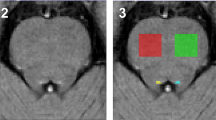Summary
An unusual case of recurrent attacks of peculiar twilight state persisting for 41 years is the subject of this clinicopathological report. During the attacks the patient had depersonalization, showing a stiff face, and the electroencephalogram showed constant 5 Hz diffuse theta waves. The unique and characteristic neuropathological finding were many foamy spheroid bodies (FSB) in the substantia nigra which sometimes contained varying numbers of fine or coarse eosinophilic granules. Ultrastructurally, the FSB contained various small electron-dense granules and/or membranous structures quite different from so-called spheroids (axonal swellings). Bodian staining demonstrated that some FSB were situated within the bundles of the neuronal processes, suggesting that the FSB has originated from the degeneration of the axon and/or dendrites in the substantia nigra.
Similar content being viewed by others
References
Donahue S, Zeman W, Watanabe I (1967) Electron microscopic observations in Batten's disease. In: Aronson SM, Volk BW (eds) Inborn disorders of sphingolipid metabolism. Pergamon Press, New York, pp 3–22
Duffy PE, Kornfeld M, Suzuki K (1968) Neurovisceral storage disease with curvilinear bodies. J Neuropathol Exp Neurol 27:351–370
Honda Y (1960) Clinical studies on the diencephalon-related psychic symptoms (in Japanese). Psychiatr Neurol Jpn 62:297–325
Jellinger K (1973) Neuroaxonal dystrophy: its natural history and related disorders. In: Zimmerman MM (ed) Progress in neuropathology, vol 2. Grune and Stratton, New York, pp 129–180
Kosaka K, Matsushita M, Oyanagi S, Uchiyama S, Iwase S (1981) Pallido-nigro-luysial atrophy with massive appearance of corpora amylacea in the CNS. Acta Neuropathol (Berl) 53:169–172
Lake BD (1984) Lysosomal enzyme deficiencies. In: Adams JH, Corsellis JAN, Duchen LW (eds) Greenfield's neuropathology, 4th edn. Arnold, London, pp 421–572
Pallis CA, Duckett S, Pearse AGE (1967) Diffuse liposuscinosis of the central nervous system. Neurology 17:381–394
Shiraki H, Yase Y (1975) Amyotrophic lateral sclerosis in Japan. In: Vinken PJ, Bruyn GW (eds) Handbook of clinical neurology, vol 22. North-Holland, Amsterdam, pp 353–419
Suzuki Y, Narama I (1987) Is the spheroid in the globus pallidus of Macaca irus identical to that dystrophic axon? Neuropathology (Kyoto) 8:90–91
Terry RD, Korey SR (1960) Membranous cytoplasmic granules in infantile amaurotic idiocy. Nature 188:1000–1002
Yagishita S (1978) Morphological investigations on axonal swellings and spheroids in various human diseases. Virchows Arch [A] 378:181–197
Zeman W, Donhue S, Dyken P, Green J (1970) The neuronal ceroid-lipofuscinoses (Batten-Vogt syndrome). In: Vinken PJ, Bruyn GW (eds) Handbook of clinical neurology, vol 10. North-Holland, Amsterdam, pp 588–679
Author information
Authors and Affiliations
Rights and permissions
About this article
Cite this article
Arai, N., Honda, Y., Amano, N. et al. Foamy spheroid bodies in the substantia nigra. J Neurol 235, 330–334 (1988). https://doi.org/10.1007/BF00314227
Received:
Revised:
Accepted:
Issue Date:
DOI: https://doi.org/10.1007/BF00314227




